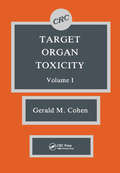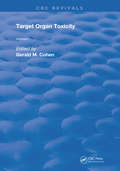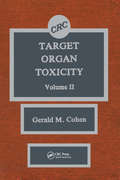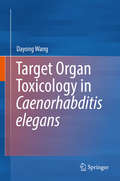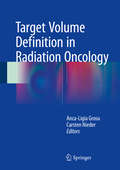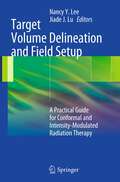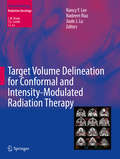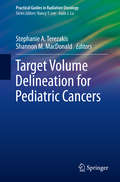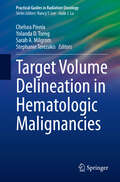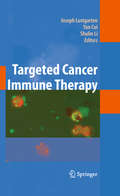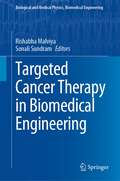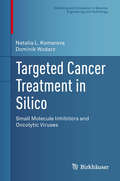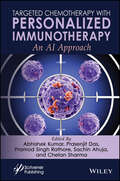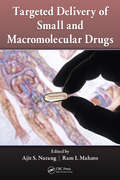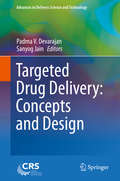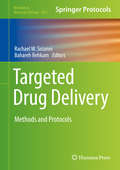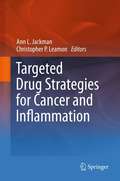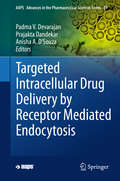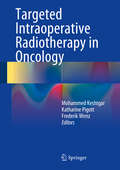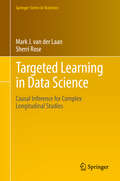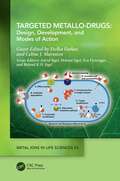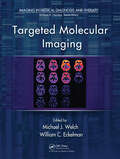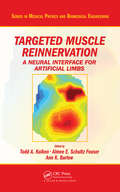- Table View
- List View
Target Organ Toxicity, Volume I: Volume 2 (Routledge Revivals Ser.)
by Gerald M. CohenThis two-volume set provides essential information on the general princi-ples of target organ toxicity. Pharmacokinetics, metabolic activation and key defense mechanisms, excretion, species variation, and tissue-specific biochemistry are explored comprehensively. These general principles are then illustrated using specific examples of toxicity to different target organs and systems. DNA modifi-cation and repair in tumor induction, and specificity in tumor initiation are also examined. Of primary interest to toxicologist, pharma-cologists, biochemists, and environmental toxicologists.
Target Organ Toxicity: Volume 1 (Routledge Revivals)
by Gerald M. CohenFirst published in 1986: The purpose of these volumes is to provide a valuable reference for established investigators and postgraduate students in toxicology.
Target Organ Toxicity: Volume 2 (Routledge Revivals)
by Gerald M. CohenFirst published in 1986: This two-volume set provides essential information on the general princi-ples of target organ toxicity. Pharmacokinetics, metabolic activation and key defense mechanisms, excretion, species variation, and tissue-specific biochemistry are explored comprehensively. These general principles are then illustrated using specific examples of toxicity to different target organs and systems. DNA modifi-cation and repair in tumor induction, and specificity in tumor initiation are also examined. Of primary interest to toxicologist, pharma-cologists, biochemists, and environmental toxicologists.
Target Organ Toxicology in Caenorhabditis elegans
by Dayong WangThis book introduces readers to intestinal and epidermal barriers, and to toxicity induction of environmental toxicants or stresses in the intestine, epidermis, neurons, muscle, and reproductive organs in Caenorhabditis elegans. In addition, it discusses the protective responses of various organs and nematodes’ avoidance behaviour with regard to environmental toxicants or stresses. The intestinal, epidermal, neuronal, and germline signalling pathways required for the regulation of toxicity of environmental toxicants or stresses are also introduced and discussed. As a classic model animal with well-described genetic and developmental backgrounds, the nematode Caenorhabditis elegans has been successfully and widely used in both toxicity assessments and toxicological studies on various environmental toxicants and stresses. Once exposure to certain environmental toxicants has occurred, the toxicants can enter into the primary targeted organs (such as intestinal cells), and even be translocated into secondary targeted organs (such as reproductive organs and neurons). Based on related available data, this book provides a systematic understanding of target organ toxicology in C. elegans.
Target Volume Definition in Radiation Oncology
by Carsten Nieder Anca-Ligia GrosuThe main objective of this book is to provide radiation oncologists with a clear, up-to-date guide to tumor delineation and contouring of organs at risk. With this in mind, a detailed overview of recent advances in imaging for radiation treatment planning is presented. Novel concepts for target volume delineation are explained, taking into account the innovations in imaging technology. Special attention is paid to the role of the newer imaging modalities, such as positron emission tomography and diffusion and perfusion magnetic resonance imaging. All of the most important tumor entities treated with radiation therapy are covered in the book. Each chapter is devoted to a particular tumor type and has been written by a recognized expert in that topic.
Target Volume Definition in Radiation Oncology
by Carsten Nieder Anca-Ligia Grosu Nils Henrik NicolayThis updated edition of the book provides radiation oncologists with a structured, state-of-the-art guide to target volume delineation for all major cancer types. It provides an overview of recent advances in radiation treatment techniques and multimodal imaging for radiation treatment planning. It also offers clear and structured guidelines for the contouring of target volumes and organs at risk, taking into account the available imaging modalities including PET/CT and multiparametric MR imaging. Each chapter addresses the target volume concepts of a particular tumor type and has been written by experts in the field. Covering all major tumor entities, the book provides practicing radiation oncologists with a guide to defining target volumes based on multimodal imaging.
Target Volume Delineation and Field Setup
by Jiade J. Lu Nancy Y. LeeThis handbook will enable radiation oncologists to appropriately and confidently select and delineate tumor volumes/fields for conformal radiation therapy, including intensity-modulated radiation therapy (IMRT), in patients with commonly encountered cancers. The orientation of this handbook is entirely practical, in that the focus is on the illustration of clinical target volume (CTV) delineation for each major malignancy. Each chapter provides guidelines and concise knowledge on treatment planning and CTV selection, explains how the anatomy of lymphatic drainage shapes target volume selection, and presents detailed illustrations of delineations, slice by slice, on planning CT images. While the emphasis is on target volume delineation for three-dimensional conformal therapy and IMRT, information is also provided on conventional radiation therapy field setup and planning for certain malignancies for which IMRT is not currently suitable.
Target Volume Delineation for Conformal and Intensity-Modulated Radiation Therapy: A Practical Guide For Conformal And Intensity-modulated Radiation Therapy (Medical Radiology)
by Jiade J. Lu Nancy Y. Lee Nadeem RiazThis textbook is designed to help the busy radiation oncologist to accurately and confidently delineate tumor volumes for conformal radiation therapy (including IMRT). The book provides an atlas of clinical target volumes (CTVs) for commonly encountered cancers, with each chapter illustrating CTV delineation on a slice-by-slice basis, on planning CT images. Common anatomic variants for each tumor are represented in individual illustrations, with annotations highlighting differences in coverage. The anatomy of each site and patterns of lymphatic drainage are discussed, and their influence on the design of CTVs is explained in detail. Utilization of other imaging modalities, including MRI, to delineate volumes is highlighted. Key details of simulation and planning are briefly reviewed. Although the emphasis is on target volume delineation for conformal techniques, information is also provided on conventional radiation field setup and design when IMRT is not suitable.
Target Volume Delineation for Pediatric Cancers (Practical Guides in Radiation Oncology)
by Stephanie A. Terezakis Shannon M. MacDonaldThis handbook is designed to provide the radiation oncologist with clear practical guidance in the delineation of tumor volumes and/or radiation fields for a wide variety of pediatric cancers, including the most frequently encountered malignancies of childhood. This is a guide to designing treatment fields and volumes that may be utilized in the delivery of conformal therapies such as intensity-modulated radiation therapy and proton therapy, the latter being particularly relevant in children. Each chapter focuses on a specific tumor type, providing general guidelines that will assist the reader in delineating the clinical target volume for particular presentations, including patterns of spread. As the target volumes can be complex, detailed illustrations are presented of the volumes in representative cases, contoured slice by slice on the planning CT images. In addition to target volume delineation for conformal treatment, field design setup for conventional approaches is also discussed.
Target Volume Delineation in Hematologic Malignancies (Practical Guides in Radiation Oncology)
by Chelsea Pinnix Yolanda D. Tseng Sarah A. Milgrom Stephanie TerezakisThis practical guide provides radiation oncologists with clear, practical guidelines for delineating target volumes and radiation fields for a diverse group of hematologic malignancies. The treatment fields and volumes described in this guide can be used when treating with conformal therapies, such as intensity-modulated radiotherapy (IMRT) and/or proton therapy. Each chapter focuses on clinical target volume (CTV) contouring for specific hematologic malignancies, including lymphomas, leukemias and plasma cell neoplasms. Since target volumes can be complex in certain clinical circumstances, each chapter includes multiple, detailed illustrations of the volumes in representative cases contoured slice by slice in the planning CT images, with accompanying diagnostic images that are commonly used in image fusion. The book will be a valuable resource for practicing radiation oncologists, medical physicists, medical dosimetrists, residents, radiation therapists and other medical professionals.
Targeted Biomarker Quantitation by LC-MS
by Naidong Weng Wenying JianThe first book to offer a blueprint for overcoming the challenges to successfully quantifying biomarkers in living organisms The demand among scientists and clinicians for targeted quantitation experiments has experienced explosive growth in recent years. While there are a few books dedicated to bioanalysis and biomarkers in general, until now there were none devoted exclusively to addressing critical issues surrounding this area of intense research. Target Biomarker Quantitation by LC-MS provides a detailed blueprint for quantifying biomarkers in biological systems. It uses numerous real-world cases to exemplify key concepts, all of which were carefully selected and presented so as to allow the concepts they embody to be easily expanded to future applications, including new biomarker development. Target Biomarker Quantitation by LC-MS primarily focuses on the assay establishment for biomarker quantitation—a critical issue rarely treated in depth. It offers comprehensive coverage of three core areas of biomarker assay establishment: the relationship between the measured biomarkers and their intended usage; contemporary regulatory requirements for biomarker assays (a thorough understanding of which is essential to producing a successful and defendable submission); and the technical challenges of analyzing biomarkers produced inside a living organism or cell. Covers the theory of and applications for state-of-the-art mass spectrometry and chromatography and their applications in biomarker analysis Features real-life examples illustrating the challenges involved in target biomarker quantitation and the innovative approaches which have been used to overcome those challenges Addresses potential obstacles to obtain effective biomarker level and data interpretation, such as specificity establishment and sample collection Outlines a tiered approach and fit-for-purpose assay protocol for target biomarker quantitation Highlights the current state of the biomarker regulatory environment and protocol standards Target Biomarker Quantitation by LC-MS is a valuable resource for bioanalytical scientists, drug metabolism and pharmacokinetics scientists, clinical scientists, analytical chemists, and others for whom biomarker quantitation is an important tool of the trade. It also functions as an excellent text for graduate courses in pharmaceutical, biochemistry and chemistry.
Targeted Cancer Immune Therapy
by Shulin Li Joseph Lustgarten Yan CuiThe principle of cancer immune therapy remains the stimulation of the immune system to control and destroy tumors, but the scope is expanded in steady and fast pace, the approach is modernized every few years, new molecules are revealed annually, and the understanding of the mechanisms is getting deeper and deeper. Targeted Cancer Immune Therapy covers cytokine immune therapy, cell-based immune therapy, and targeted immune therapy. In each of these three sections, only the novel aspects of immune therapy were selectively described instead of attempting to cover any historical achievement. In the first section, Cytokine Immune Therapy, the IL12 family, IL18, IL21, IL24, IL28, and IL29 were heavily discussed in regard to the anti-tumor function and application in treating tumors. In the second section, Cell-based Immune Therapy, the focus was given to engineering potent immune regulatory or effector cells such as dendritic cells, T cells, and stem cells. The cell engineering design is primarily based on the increased understanding of the interaction of tumor antigen presenting cells, antigen specific effector cells, and the tumor microenvironment. In the third section, Targeted Immune Therapy, the focus was given on rearticulating the antibody therapy for boosting immune response, which includes immunocytokines, "T-body", and tumor targeted CpG ODN. Immunocytokines represent a new class of biopharmaceuticals composed of two well known immune components - antibodies and cytokines - with the unique ability to target cytokines to the tumor microenvironment and thereby activate antitumor responses. Some or all of these innovative approaches may ultimately become the future effective immune therapy for treating malignancy.
Targeted Cancer Therapy in Biomedical Engineering (Biological and Medical Physics, Biomedical Engineering)
by Rishabha Malviya Sonali SundramThis book highlights the role of Biomedical Engineering (BME) used in diagnosis (e.g., body scanners) and treatment (radiation therapy and minimal access surgery in order to prevent various diseases). In recent years, an important progress has been made in the expansion of biomedical microdevices which has a major role in diagnosis and therapy of cancer. When fighting cancer, efficacy and speed are of the utmost importance. A recently developed microfluidic chip has enabled a breakthrough in testing the efficacy of specialized cancer drugs.Effective cancer-targeting therapies will require both passive and active targeting strategies and a thorough understanding of physiologic barriers to targeted drug delivery. Targeted cancer treatments in development and the new combinatorial approaches show promise for improving targeted anticancer drug delivery and improving treatment outcomes.This book discusses the advancements and innovations in the field of BME that improve the diagnosis and treatment of cancer. This book is focused on bioengineering approaches to improve targeted delivery for cancer therapeutics, which include particles, targeting moieties, and stimuli-responsive drug release mechanisms. This book is a useful resource for students, researchers, and professionals in BME and medicine.
Targeted Cancer Treatment in Silico
by Natalia L. Komarova Dominik WodarzCountless medical researchers over the past century have been occupied by the search for a cure of cancer. So far, they have developed and implemented a wide range of treatment techniques, including surgery, chemo- and radiotherapy, antiangiogenic drugs, small molecule inhibitors, and oncolytic viruses. However, patterns of these treatments' effectiveness remain largely unclear, and a better understanding of how cancer therapies work has become a key research goal. Cancer Treatment in Silico provides the first in-depth study of approaching this understanding by modeling cancer treatments, both mathematically and through computer simulations. The main goal of this book is to help expose students and researchers to in silico methods of studying cancer. It is intended for both the applied mathematics and experimental oncology communities, as mathematical models are playing an increasingly important role to supplement laboratory biology in the fight against cancer. Written at a level that generally requires little technical background, the work will be a valuable resource for scientists and students alike.
Targeted Chemotherapy with Personalized Immunotherapy: An AI Approach
by Abhishek Kumar Chetan Sharma Pramod Singh Rathore Prasenjit Das Sachin AhujaTargeted Chemotherapy with Personalized Immunotherapy: An AI Approach is an essential guide for healthcare teams, offering groundbreaking insights into novel immunotherapies and personalized treatments to improve cancer patient care and quality of life. In the last 20 years, there have been significant leaps forward in the treatment of cancer. We now have a far better understanding of how our cells interact with one another, how cancer suppresses and hides from the immune system, and how to support the body in reacting to stop the spread of cancer. Nevertheless, there is still a great deal more to learn in this field. Researchers are working to develop methods that will help pinpoint the most effective treatment for patients. Through this research, they have discovered that, for certain patients, the best results may be reached by combining precisely targeted chemotherapy with personalized immunotherapy. Instead of treating patients with medications that are detrimental to the body as a whole, researchers now aim to identify the molecules that play an essential part in the communication that takes place between cells. This study will help pave the way for the development of novel immunotherapies that will help the body in its fight against cancer. In order to accurately plan cancer treatment, participation from a number of different members of the healthcare team is essential. This book is a comprehensive guide for all members of this team, providing insights into groundbreaking new treatments to cure more patients and improve quality of life.
Targeted Delivery of Small and Macromolecular Drugs
by Ram I. Mahato Ajit S. NarangSite-specific drug delivery and targeting attracts much research interest from both academia and industry, but because of the many challenges faced in the development of these systems, only a handful of targeted therapies have successfully made it into clinical practice. Focusing on the delivery technologies that utilize both systemic and local rou
Targeted Drug Delivery: Concepts and Design
by Padma V. Devarajan Sanyog JainThis authoritative volume explores the fundamental concepts and numerous applications of targeted delivery of drugs to the body. This compilation has been divided into eight sections comprised of the basic principles of drug targeting, disease and organ/organelle-based targeting, passive and active targeting strategies, and various advanced drug delivery tools such as functionalized lipidic, polymeric and inorganic nanocarriers. Together, the twenty-three chapters cover a wide range of topics in the field, including tumor and hepatic targeting, polymer-drug conjugates, nanoemulsion, physical and biophysical characteristics of nanoparticles, and in vivo imaging techniques, among others. The book also examines advanced characterization techniques, regulatory hurdles and toxicity-related issues that are key features for successful commercialization of targeted drug delivery system products. Targeted Drug Delivery is a comprehensive reference guide for drug delivery researchers, both beginners and those already working in the field.
Targeted Drug Delivery: Methods And Protocols (Methods in Molecular Biology #1831)
by Rachael W. Sirianni Bahareh BehkamThis volume looks at the latest techniques used to enable therapeutic molecules to be targeted for site-specific delivery. The chapters in this book discuss topics such as approaches to express biologically derived and synthetic nanocarriers; strategies to assist in nanocarrier targeting to specific cells and tissues; and methods for evaluating delivery and efficiency for new classes of agents. Written in the highly successful Methods in Molecular Biology series format, chapters include introductions to their respective topics, lists of the necessary materials and reagents, step-by-step, readily reproducible laboratory protocols, and tips on troubleshooting and avoiding known pitfalls.Cutting-edge and comprehensive, Targeted Drug Delivery: Methods and Protocols is a valuable resource for anyone interested in understanding the diversity of methods used in this evolving field.
Targeted Drug Strategies for Cancer and Inflammation
by Christopher P. Leamon Ann L. JackmanFolate pathways are essential in metabolism and macromolecule synthesis. Antifolate drugs that are largely transported via a high capacity folate transporter (i.e. the reduced-folate carrier) and inhibit folate-dependent enzymes include the dihydrofolate reductase inhibitor, methotrexate, and the thymidylate synthase inhibitors, raltitrexed and pemetrexed. Major advances in folate research made within the last decade include (i) the approval of pemetrexed for the treatment of lung cancer and mesothelioma, and (ii) the demonstration that cell membrane-anchored folate receptors (FR) are exploitable for cancer and inflammatory disease management. FRs are not widely distributed in normal tissues, except on some luminal surfaces; however, they are accessible to systemically administered agents when expressed on many cancers as well as on activated macrophages involved in various inflammatory diseases. High affinity folate-radioisotope conjugates have been developed for imaging pathogenic FR-positive diseases, including cancer. Since the FR transports folates via a low capacity but high affinity endocytic pathway, a variety of FR-targeted antifolate drugs and folate conjugates bearing a wide range of payloads (including cytotoxic drugs) are currently being developed which exploit this property. The FR is also being utilized in immunotherapy approaches for the treatment of overexpressing cancers.
Targeted Intracellular Drug Delivery by Receptor Mediated Endocytosis (AAPS Advances in the Pharmaceutical Sciences Series #39)
by Padma V. Devarajan Prajakta Dandekar Anisha A. D’SouzaThis book elaborates on drug delivery targeting via intracellular delivery, specifically through the Receptor Mediated Endocytosis (RME) approach, due to the involvement of cellular receptors in various grave diseases. Targeted delivery relies on two basic approaches, passive and active targeting. While passive targeting approaches have shown great promise, the improved selectivity achieved with active targeting approaches has resulted in significantly higher efficacy. Interestingly there are numerous strategies for active targeting, many of which are already highlighted in , Targeted Drug Delivery: Concepts and Applications. Nevertheless an exciting and practical strategy for active targeting, which could enable high intracellular delivery, is through exploitation of RME. Cells in the body express receptors to enable various physiological and biochemical processes. As a result, many of these receptors are overexpressed in pathological conditions, or newer receptors expressed due to defective cellular functioning. RME is based on exploitation of such receptors to achieve intracellular delivery. While targeted delivery can have manifold applications, in this book we focus on two major and challenging therapeutic areas; i) Cancer and ii) Infectious Diseases. Targeted Intracellular Drug Delivery by Receptor Medicated Endocytosis discusses the major receptors that are useful for targeted delivery for these afflictions. A major section of this book is dedicated to details regarding their occurrence and location, the recognition domain of the receptor, structure activity relationship of substrate /ligand for selective binding, ligands explored, antagonists for ligand binding and relevance of these aspects for therapy of cancer and infectious diseases. These facets are elucidated with the help of specific examples from academic research and also emphasize commercial products, wherever relevant. In vitro cellular models relied on for assessing receptor mediated cellular targeting and in vivo models depicting clinical efficacy are focused on in a separate section. Finally, we briefly discuss the regulatory and toxicity issues that may be associated specifically with the RME approach of intracellular drug delivery.
Targeted Intraoperative Radiotherapy in Oncology
by Katharine Pigott Mohammed Keshtgar Frederik WenzTargeted intraoperative radiotherapy is a major advance in the management of cancer patients and has been attracting massive interest worldwide following publication of the results of an important randomized controlled trial in The Lancet. This textbook is designed to introduce this innovative technology in a comprehensive manner to clinicians dealing with cancer patients. Throughout, the emphasis is on practical aspects and the text is supported by many excellent illustrations. The editors of the book have extensive experience in targeted intraoperative radiotherapy and include co-directors of the TARGIT Academy, which runs international training courses on the technology in the United Kingdom and Germany. They have brought together multidisciplinary contributors from different centers across the world who have wide experience in the field and whose work has been recognized internationally. It is the editors' hope that this book will succeed in ensuring that targeted intraoperative radiotherapy is used effectively worldwide.
Targeted Learning in Data Science: Causal Inference For Complex Longitudinal Studies (Springer Series in Statistics)
by Mark J. van der Laan Sherri RoseThis textbook for graduate students in statistics, data science, and public health deals with the practical challenges that come with big, complex, and dynamic data. It presents a scientific roadmap to translate real-world data science applications into formal statistical estimation problems by using the general template of targeted maximum likelihood estimators. These targeted machine learning algorithms estimate quantities of interest while still providing valid inference. Targeted learning methods within data science area critical component for solving scientific problems in the modern age. The techniques can answer complex questions including optimal rules for assigning treatment based on longitudinal data with time-dependent confounding, as well as other estimands in dependent data structures, such as networks. Included in Targeted Learning in Data Science are demonstrations with soft ware packages and real data sets that present a case that targeted learning is crucial for the next generation of statisticians and data scientists. Th is book is a sequel to the first textbook on machine learning for causal inference, Targeted Learning, published in 2011.Mark van der Laan, PhD, is Jiann-Ping Hsu/Karl E. Peace Professor of Biostatistics and Statistics at UC Berkeley. His research interests include statistical methods in genomics, survival analysis, censored data, machine learning, semiparametric models, causal inference, and targeted learning. Dr. van der Laan received the 2004 Mortimer Spiegelman Award, the 2005 Van Dantzig Award, the 2005 COPSS Snedecor Award, the 2005 COPSS Presidential Award, and has graduated over 40 PhD students in biostatistics and statistics.Sherri Rose, PhD, is Associate Professor of Health Care Policy (Biostatistics) at Harvard Medical School. Her work is centered on developing and integrating innovative statistical approaches to advance human health. Dr. Rose’s methodological research focuses on nonparametric machine learning for causal inference and prediction. She co-leads the Health Policy Data Science Lab and currently serves as an associate editor for the Journal of the American Statistical Association and Biostatistics.
Targeted Metallo-Drugs: Design, Development, and Modes of Action (Metal Ions in Life Sciences Series)
by Astrid Sigel Helmut Sigel Roland K. O. Sigel Eva Freisinger Etelka Farkas Celine J. MarmionVolume 24, entitled Targeted Metallo-Drugs: Design, Development, and Modes of Action, of the series Metal Ions in Life Sciences (MILS), fosters inter-disciplinary research in the vibrant field of Biological Inorganic Chemistry. Inspired by the clinical success of cisplatin as a leading anticancer drug but mindful of the shortcomings associated with its use including dose-limiting toxic side effects and acquired or intrinsic drug resistance, scientists across the globe have been endeavoring to identify new metallo-drugs for therapeutic exploitation. This has led to innovative metallo-drug candidates that (i) enhance cancer cell selectivity, thus reducing toxic side effects, and/or (ii) possess new modes of action to improve efficacy and also target resistance pathways. This and more are captured in MILS- 24 which consists of 12 comprehensive, well-illustrated, and up to date chapters with over 1600 citations, 100 figures, and 10 tables with key contributions from 32 international experts from Europe, Asia, and North and South America. MILS- 24 not only keeps the scientific community abreast of latest developments, it also serves as an invaluable resource to stimulate further research on targeted metallo-drug design and development. • It covers anticancer, antimicrobial, antiviral, and other agents, such as those targeting tropical diseases and cyanide poisoning and radiometals in molecular imaging and therapy. • It highlights recent metallo-drug developments targeting COVID-19. • It features advanced spectroscopic methods and metallomics as important tools to elucidate the modes of actions of metallo-drugs.
Targeted Molecular Imaging (Imaging in Medical Diagnosis and Therapy)
by William C. Eckelman Michael J. WelchTargeted Molecular Imaging covers the development of novel diagnostic approaches that use an imaging probe and agent to noninvasively visualize cellular processes in normal and disease states. It discusses the concept, development, preclinical studies, and, in many cases, translation to the clinic of targeted imaging agents. The many case studies t
Targeted Muscle Reinnervation: A Neural Interface for Artificial Limbs (Series in Medical Physics and Biomedical Engineering)
by Todd A. Kuiken Aimee E. Schultz Feuser Ann K. BarlowImplement TMR with Your Patients and Improve Their Quality of LifeDeveloped by Dr. Todd A. Kuiken and Dr. Gregory A. Dumanian, targeted muscle reinnervation (TMR) is a new approach to accessing motor control signals from peripheral nerves after amputation and providing sensory feedback to prosthesis users. This practical approach has many advantage
